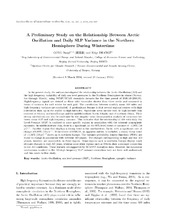| dc.description.abstract | In the present study, the authors investigated the relationship between the Arctic Oscillation (AO) and the high-frequency variability of daily sea level pressures in the Northern Hemisphere in winter (November through March), using NCEP/NCAR reanalysis datasets for the time period of 1948/49-2000/01. High-frequency signals are defined as those with timescales shorter than three weeks and measured in terms of variance, for each winter for each grid. The correlations between monthly mean AO index and high-frequency variance are conducted. A predominant feature is that several regional centers with high correlation show up in the middle to high latitudes. Significant areas include mid- to high-latitude Asia centered at Siberia, northern Europe and the middle-latitude North Atlantic east of northern Africa. Their strong correlations can also be confirmed by the singular value decomposition analysis of covariance between mean SLP and high-frequency variance. This indicates that the relationship of AO with daily Sea Level Pressure (SLP) is confined to some specific regions in association with the inherent atmospheric dynamics. In middle-latitude Asia, there is a significant (at the 95% level) trend of variance of –2.26% (10 yr)−1. Another region that displays a strong trend is the northwestern Pacific with a significant rate of change of 0.80% (10 yr)−1. If the winter of 1948/49, an apparent outlier, is excluded, a steady linear trend of +1.51% (10 yr)−1 shows up in northern Europe. The variance probability density functions (PDFs) are found to change in association with different AO phases. The changes corresponding to high and low AO phases, however, are asymmetric in these regions. Some regions such as northern Europe display much stronger changes in high AO years, whereas some other regions such as Siberia show a stronger connection to low AO conditions. These features are supported by ECMWF reanalysis data. However, the dynamical mechanisms involved in the AO-high frequency SLP variance connection have not been well understood, and this needs further study. | en_US |
